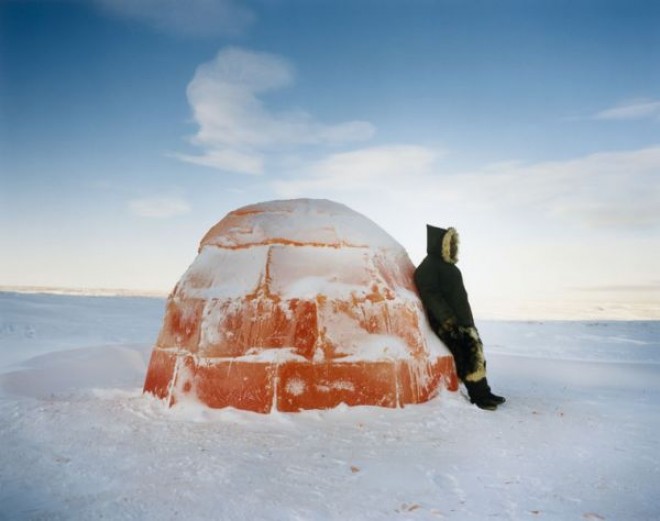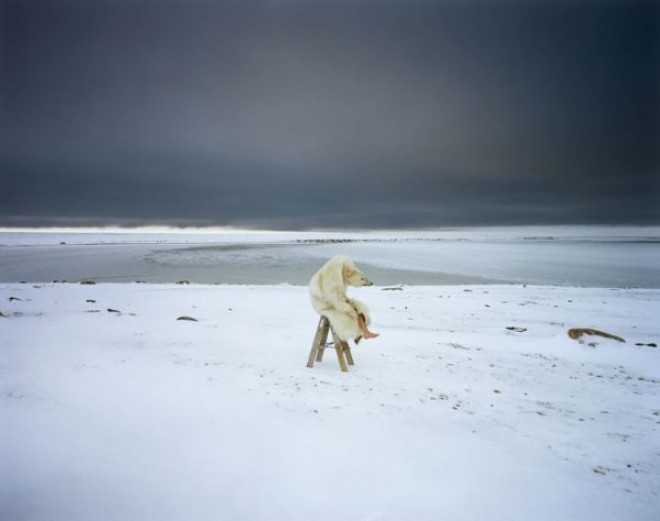Scarlett Hooft Graafland is an explorer. Whether it’s travelling to remote parts of the world to take images of extreme communities, or simply blurring the borders between straight photography and sculpture the Dutch photographer pushes into new territories. Having lived with Eskimos in remotest North Canada for four months to rural China her photographs mix the surreal and the sublime.
Twin spoke to the 38-year-old about her work…
How long have you been a photographer?
I’ve been a photographer for eight years. Before I used to take photos but not in such a serious way, those pictures were more documentations of sculptures I made. It was only later that I started using photography as the actual work, the “end product”.
What kind of photographer would you describe yourself as?
I would rather describe myself as a visual artist who makes photographs. I trained as a sculptor, first at the Royal Academy of Fine Arts in The Hague, later at Parsons School of Design in New York. Inhabiting the border between straight photography, performance and sculpture, my photographs are records of highly choreographed live performances made in remote and often surreal landscapes. Many times I refer to a more profound cultural discourse of my surroundings.

Your photos are so otherworldly, what locations have you travelled to to make your images happen?
I’ve traveled to many places, most of the time locations that are hard to reach, like a small Inuit settlement in arctic Canada, the salt desert in Bolivia and high in the Norwegian mountains where the herds of reindeer live. I also spent time in the south of China, this was a challenge language wise.
Are they of spontaneous moments or do you plan them?
I like to do some planning before, but most of the time, once you get to a place, the circumstances are different to what I had in mind. Also the fact that I am dependent on the local community has some impact on the actual photo, how much they want to help me, where we can go, how close we can get to the reindeer for example, a lot of unexpected situations I have to work with. Also the weather is an important factor, sometimes I have to wait for days, in a few cases weeks, for the weather to clear up. So a lot of improvisation.

Is it difficult as a female photographer going to remote places?
It can be difficult, I had some tough situations. But many times I happened to meet really nice people, people who were willing to help. I also try to go to places where I have some contacts, through friends, friends of friends, that really helps. And mostly I use my intuition, who to travel with, where to stay at peoples houses etc.
What inspires you?
I like to find places where people live close to nature, places where it is hard to survive and where the power of nature is strong. It is fascinating to me to see how people live with old traditions, and to be able to live with them for some time, to experience a little that way of life. I normally stay for a few months at the time to get a better understanding about the living circumstances, the culture, etc. And this knowledge can also have some impact on the photos I make.
My work is rooted in a Western tradition, but it also enters all sorts of engagements with new traditions, other cultures, remarkable locations, and fascinating people. I have gradually built a nomadic oeuvre that is intercultural while also displaying a strong unity of style; temporary in its individual landscape interventions, but long-term in its engagement with the world.

What’s the most amazing thing you’ve seen as a photographer?
I don’t know the most amazing thing, but living with a semi nomad Inuit family on their sled and traveling on the sea ice for a few weeks was an amazing experience. It was in springtime, when it did not get dark and in the middle of the night the light was kind of magic. In that time I made the work “My White Night”, a dog sled carrying a big “moon” through the winter landscape.
Where next do you want to travel to?
In March I’m going to Bolivia, to the Altiplano. I’ve been there many times already and it’s an amazing place! I work together with a Bolivian artist, Gaston Ugalde, and it’s very special to travel with him and his crew through the highlands in a Landover with piles of materials on top of the roof.
Do you have an upcoming exhibition or publication?
The 16th of March is the opening of the show ‘Almas Saladas’ at the Museo Nacional de Arte in La Paz, Bolivia, together with Gaston Ugalde. Also I am working on a book right now about all my works made in the Altiplano, that will come out in April, published by W-Books.




 Twitter
Twitter
 Tumblr
Tumblr
 YouTube
YouTube
 Facebook
Facebook
 Instagram
Instagram
